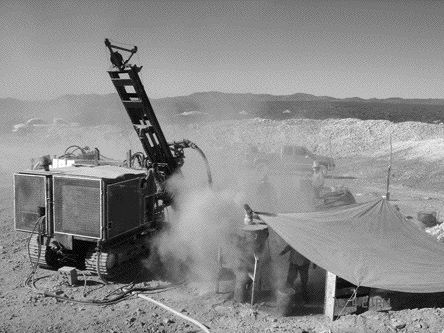Vancouver — For the second time in two weeks, Canplats Resources (CPQ-V, CPQRF-O) got a share price boost on results from the company’s Camino Rojo discovery in Zacatecas state, Mexico.
The first results from Camino Rojo came from three holes drilled in different directions from the same collar in the Repressa zone. Those results lifted Canplats’ share price 170% to a new all-time high.
The next set of results from the project included two long, well-mineralized intersections starting at surface and a short, high-grade intercept from a new zone.
Hole 6, collared in the Repressa zone, 45 metres south of the initial collar, intersected 183 metres of mineralized oxide from surface grading 1.61 grams gold per tonne, 12.84 grams silver, 0.49% lead and 0.31% zinc. The intersection included 72 metres of 2.59 grams gold, 18.03 grams silver, 0.76% lead and 0.33% zinc, starting 68 metres down-hole.
Hole 4 was drilled 115 metres south of the initial collar, near the southern limit of the Repressa zone, as defined by airborne geophysics. The hole returned 180 metres from surface averaging 0.66 gram gold, 11.55 grams silver, 0.21% lead and 0.34% zinc. The bottom of the hole returned 10 metres of sulphide mineralization grading 0.78 gram gold, 11.04 grams silver, 0.16% lead and 0.49% zinc, the first mineralized sulphide encountered on the project.
Hole 5 was a wildcat hole drilled in a new area called the Don Julio zone, which was defined by an induced-polarization survey. The hole cut 8 metres grading 2.27 grams gold and 5.56 grams silver, confirming that the area is mineralized.
Canplats’ share price rose 15, or 7.6%, on the news, closing at $2.21 on 3.2 million shares traded. The company has a 52-week trading range of 23-$2.34 with 48.8 million shares issued.
Results from four further holes are pending and Canplats plans to continue drilling into late December.
Canplats geologists discovered the Camino Rojo zone when they traced red-stained roadfill to its quarry. Canplats quickly staked some 1,000 sq. km of ground and started a test-pitting program at the aptly named “Red Road” project. Pits dug at 50-metre intervals returned individual samples assaying up to 6.18 grams gold, 1.24% zinc and 1.46% lead.
The pit sampling defined a 600 by 450-metre area, with a higher-grade zone at the core. Represa remains open to the east and west, where pit sampling could not reach bedrock. The current reverse-circulation drill program is expected to total 1,700 metres. Canplats is bringing two diamond-drill rigs on-site in the new year.
Mineralization in the Represa zone is hosted in weak to moderately silicified, laminated siltstones and sandstones with moderate to intense hematite alteration and localized zones with weak to moderate brecciation and fine quartz micro-veinlets. Mineralization starts at surface, covered by an overburden ranging in depth from 0.25 to 3 metres.


Be the first to comment on "Camino Rojo results keep Canplats rising"